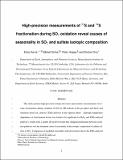High-Precision Measurements of [superscript 33]S and [superscript 34]S Fractionation during SO[subscript 2] Oxidation Reveal Causes of Seasonality in SO[subscript 2] and Sulfate Isotopic Composition
Author(s)
Harris, Eliza; Sinha, Barbel; Hoppe, Peter; Ono, Shuhei
DownloadOno - Harris article.pdf (1.386Mb)
PUBLISHER_POLICY
Publisher Policy
Article is made available in accordance with the publisher's policy and may be subject to US copyright law. Please refer to the publisher's site for terms of use.
Terms of use
Metadata
Show full item recordAbstract
This study presents high-precision isotope ratio-mass spectrometric measurements of isotopic fractionation during oxidation of SO[subscript 2] by OH radicals in the gas phase and H[subscript 2]O[subscript 2] and transition metal ion catalysis (TMI-catalysis) in the aqueous phase. Although temperature dependence of fractionation factors was found to be significant for H[subscript 2]O[subscript 2] and TMI-catalyzed pathways, results from a simple 1D model revealed that changing partitioning between oxidation pathways was the dominant cause of seasonality in the isotopic composition of sulfate relative to SO[subscript 2]. Comparison of modeled seasonality with observations shows the TMI-catalyzed oxidation pathway is underestimated by more than an order of magnitude in all current atmospheric chemistry models. The three reactions showed an approximately mass-dependent relationship between [superscript 33]S and [superscript 34]S. However, the slope of the mass-dependent line was significantly different to 0.515 for the OH and TMI-catalyzed pathways, reflecting kinetic versus equilibrium control of isotopic fractionation. For the TMI-catalyzed pathway, both temperature dependence and [superscript 33]S/[superscript 34]S relationship revealed a shift in the rate-limiting reaction step from dissolution at lower temperatures to TMI-sulfite complex formation at higher temperatures. 1D model results showed that although individual reactions could produce Δ[superscript 33]S values between −0.15 and +0.2‰, seasonal changes in partitioning between oxidation pathways caused average sulfate Δ[superscript 33]S values of 0‰ throughout the year.
Date issued
2013-09Department
Massachusetts Institute of Technology. Department of Earth, Atmospheric, and Planetary SciencesJournal
Environmental Science & Technology
Publisher
American Chemical Society (ACS)
Citation
Harris, Eliza, Barbel Sinha, Peter Hoppe, and Shuhei Ono. “High-Precision Measurements of [superscript 33]S and [superscript 34]S Fractionation during SO[subscript 2] Oxidation Reveal Causes of Seasonality in SO[subscript 2] and Sulfate Isotopic Composition.” Environ. Sci. Technol. 47, no. 21 (November 5, 2013): 12174–12183.
Version: Author's final manuscript
ISSN
0013-936X
1520-5851